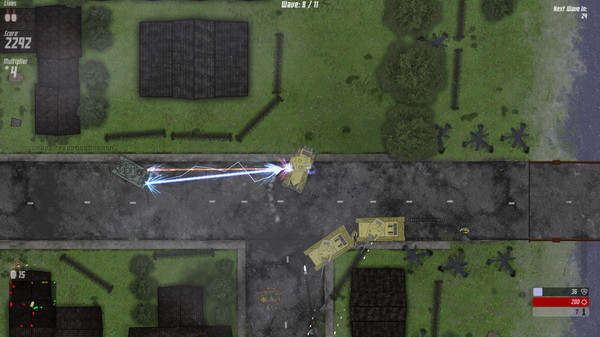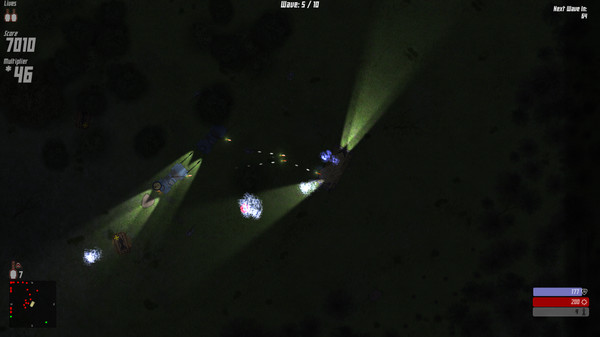Indie developer 10ft’s The Red Front seeks to combine WWII enthusiasm with classic arcade shooter action to create something interesting and fun. The main draw here is the fact that you play as the Russian Army on the front often overlooked in popular histories and depictions of the war. The game itself provides a good amount of challenge, though focusing on either the war theme or arcade style would likely have resulted in a better game, as there are some difficult-to-ignore problems that keep it from standing out and succeeding in its mission.
The Basics
The Red Front is set in World War II-era Europe, in what the developers call an alternate timeline of events. You pilot a new, experimental Russian tank in a bid to push back the Nazi threat. The campaign is made up of eight missions, taking you from Moscow through Poland and eventually to Berlin itself. There’s also a short training mission that acquaints you with basic controls, weapon upgrades, targeting, and other foundational concepts.
As you’d expect in a game styling itself as a classic arcade shooter, The Red Front emphasizes action and reflex over other mechanics. If you’re thinking the campaign sounds awfully short, there’s more to it than you might think. The training mission is deceptively simple, true, and takes less than five minutes to complete. However, the difficulty rapidly escalates. The goal in each campaign mission is to survive a set number of enemy waves, with each wave consisting of more enemies and enemy types than the previous, and each lasting about a minute and a half before the next wave arrives.
Your tank has an armor gauge and a health gauge, both of which begin at 100. As you take hits, the armor gauge depletes, and once it’s down to 0, the health gauge begins to deplete. If you go without taking damage for a few seconds, though, both meters start to slowly refill. You get three chances to succeed, and there are no in-mission checkpoints. Once you lose (which you likely will at first) you must start the mission from the very beginning.
Progression
Most maps are fairly basic, with some burnt or bombed-out buildings and trees that get in the way more than anything else, and that’s most of what you’ll see over and over again. There are random weather effects, such as rain and snow, and you also get the choice to replay missions at night, which significantly increases the difficulty. At times, it’s a chore picking out enemies on the screen, especially if it happens to be raining (dreary-grey and Nazi-grey tend to blend). But there’s a useful radar in the lower-left corner of the screen that you’ll probably rely on a good deal.
The first waves start out relatively easy, with decent-sized Nazi hordes assaulting your tank. You can choose to shoot them with your standard gun, obviously, or you can run them over, which can be a useful tactic when surrounded. Gradually, some soldiers wielding rocket launchers show up, and eventually, there are enemy vehicles of various types that speedily locate your position and attack relentlessly. You do get some support in the form of a handful of Russian soldiers. The AI is decent, and the support is very helpful, but in most cases, it’s short-lived, since your comrades just can’t compete in number and quickly get overwhelmed.

Throughout the course of each mission, enemies drop various upgrades and bonuses. These range from refilling your armor gauge or rockets to upgrading your standard gun. Most are useful, though the benefits of weapon upgrades are slightly dubious in form and function. For example, the first set of upgrades has you shoot out what looks to be chunks of ice, and after that, you shoot out beams of electricity.
There’s no real reason for the changed appearance, since the weapon itself has no special effect on enemies—only some increased firepower. Moreover, some of the upgraded levels, like the electric beam, actually require you to pause for a moment before shooting again, offsetting the marginal increase in firepower and making one wonder whether upgrading from the snow-cone shooter is really worthwhile.
You’ll earn rubles for completed missions and based on your score, which you can use to purchase permanent upgrades, like the tank’s armor and so on, and these upgrades do make surviving missions a bit easier. Yet getting to the point where your tank can survive enemy onslaughts is a bit more frustrating than it should be. The first mission itself is quite difficult. I’m not one to complain at high difficulty levels in video games, but this is close to being imbalanced. It’s satisfying to finally complete a level, but given the lack of checkpoints, if you don’t have, say, 20 minutes to replay a mission until you win, it quickly becomes frustrating, an artificial way of providing length and something akin to greater substance.
The Technical Stuff
The Red Front supports keyboard-and-mouse control schemes and a gamepad, so there’s a scheme to fit everyone. Keyboard controls are passable, though moving the tank can feel clunky, and it’s easy to get the tank and turret positions mixed to where you find you’re moving in the direction opposite the one you really want to go in. Gamepad controls would probably be the easiest for movement, though the precision of the mouse can’t be beat. However, I never lost a mission because of moving the wrong way, so it’s really a minor annoyance at most, and whatever control style you’re most comfortable with should suit you just fine.
The music is non-intrusive but unremarkable, and the graphics are the same, relying on muddy textures and muted tones to set a mood. But neither is the game’s main focus, so it doesn’t necessarily take away from the experience.
Dodgy Decisions
What’s more of a problem is the game’s premise. 10ft Games bills this as taking place in an alternate timeline, where the Red Army takes the fight to Hitler himself. The concepts of the super tank, weapon upgrades, and enemy manipulation are based on occult research the Nazis undertook during the war as well. Now, there’s not much reason to put story into an arcade shooter. But if a developer does, then it should at least make sense. The Red Army did, in fact, invade Berlin (before the other Allies); it was their presence in the city that prompted Hitler to commit suicide. And the Russian offensive did begin with efforts to expel the Nazis from Russia, before pushing onward to Germany. Other than the fact that Moscow is only optionally snowy in the period when it should have been snowbound, there’s not much of an alternative timeline going on here and even less reason to try and include it to begin with.
“But,” I hear you say, “what about the occult research? That’s interesting, true, and really does play a role in the game!” Until you realize that the subjects the Nazis used for this research were the thousands upon thousands of victims at Auschwitz, Dachau, and the other killing centers in Eastern Europe, which means 10ft chose to try and capitalize (and badly, at that) on those experiences to promote their product. It’s one of the major points they use to try and set this apart from other arcade shooters and probably the only historical element that actually makes a difference in gameplay, given how it underpins the concept of weapon upgrades and the ability to mutate enemy soldiers to increase difficulty. Text may not always be the easiest medium for interpreting tone or intent, but it certainly seems the developers treat the subject insensitively and irresponsibly, tossing this out glibly as a selling point without bothering to consider the reality behind the material.
The Verdict
Some are just looking for a good arcade shooter, though, and if that’s the case, this one is a bit of a mixed bag. It has solid mechanics and offers good challenge, and for roughly seven bucks, it certainly looks appealing. In the end, though, there’s nothing overwhelmingly unique or special about The Red Front, and the balance issues and pointless attempts at creating an atmosphere keep this from being an easy one to recommend, unless you’re just using it as a filler.









Published: Nov 30, 2017 01:08 am